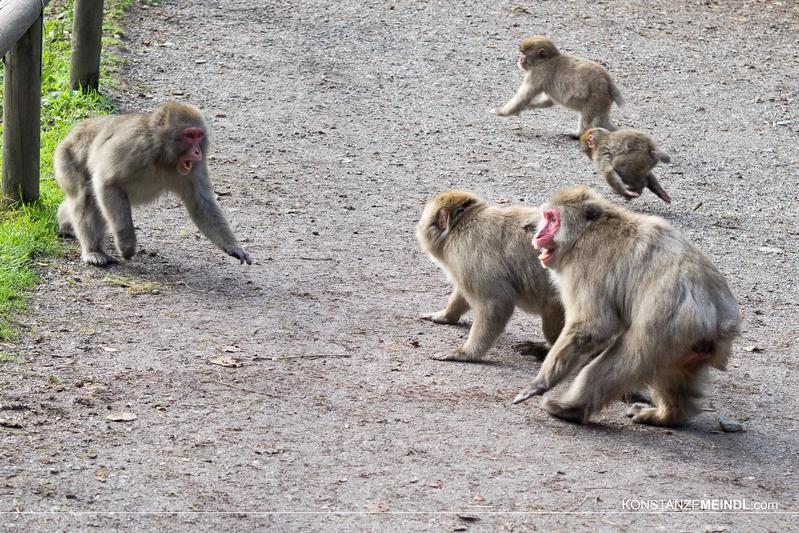

Japanese macaques are exposed to stress during rank fights.
(Photo: Konstanze Meindl)
Animals that live in groups face a variety of challenging social situations. The competition for food and mating partners as well as the establishment of the social hierarchy are potential stress factors.
Ralf Steinborn, Head of the Genomics Unit of the VetCore Facility for Research at the Vetmeduni Vienna, and ethologist Lena Pflüger from the Department of Anthropology at the University of Vienna, studied Japanese macaques living at Affenberg Landskron in Carinthia, Austria, to investigate how their genetic make-up influences the excretion of the stress hormones and the behaviour of the animals.
“Japanese macaques live in strict hierarchy which entails a high level of aggressive interaction. This makes them ideally suited for a study on stress behaviour,” says Pflüger.
Macaques differ in their stress reaction
Pflüger, first author of the study and scientific director of the Affenberg facility, studied 26 sexually mature males during the mating season, a particularly stressful time for male animals as they must compete for females. She discovered that the amount of a metabolic product of the hormone cortisol in the animals’ faeces differed across individuals.
“The macaques appear to handle stressful situations differently. Some are more courageous than others. We were interested to see whether there were genetic causes for this behaviour and how genetics affects the hormonal stress reaction and social rank,” says Pflüger.
COMT gene controls stress reaction in people
The COMT gene is one of at least 18 genes in humans that control the dopamine system in the brain. Dopamine promotes skills such as planning, decision making and problem solving. Depending on its variant, more or less of the COMT enzyme is produced from the gene, resulting in a faster or slower dopamine metabolization in the brain. Higher amounts of dopamine in the brain increase various cognitive performances but are also associated with increased stress reactions.
Steinborn and Pflüger determined the different variants of the COMT gene in Japanese macaques. This revealed that macaques with high levels of the stress hormone also possess a certain COMT variant that presumably metabolizes dopamine in the brain more slowly. The functionality of this variant and the underlying mechanism resulting in higher stress hormone levels will be determined in further studies.
“Our results indicate that animals with stress-resilient COMT variants acquire higher rank positions in the group. But a direct correlation between COMT variant and social rank has to be investigated more closely in the future,” explains Steinborn.
COMT variants make either warriors or worriers
“The dopamine level in the brain controls various behaviours in people. On the one hand, there are the so-called warrior types. In warriors, the dopamine in the brain is metabolized more quickly. Warriors possess lower cognitive skills and are less easily stressed. The second type are worriers, who score higher in cognitive performance tests but are more easily stressed. However, the dopamine system functions like an orchestra and is not dependent on just one factor,” says Steinborn.
In the future, Pflüger and Steinborn want to study other genes that play a role in the dopamine system of non-human primates. They aim to study a variety of primate species with different social styles. Another research focus will be the functionality of the newly discovered COMT gene variant at the RNA and protein levels.
Service:
The article „Allelic variation of the COMT gene in a despotic primate society: A haplotype is related to cortisol excretion in Macaca fuscata”, ba Lena S. Pflüger, Daria R. Gutleb, Martin Hofer, Martin Fieder, Bernard Wallner and Ralf Steinborn was published in the Journal Hormones and Behavior.
doi:10.1016/j.yhbeh.2015.11.012
http://www.sciencedirect.com/science/article/pii/S0018506X15301926
About the University of Veterinary Medicine, Vienna
The University of Veterinary Medicine, Vienna in Austria is one of the leading academic and research institutions in the field of Veterinary Sciences in Europe. About 1,300 employees and 2,300 students work on the campus in the north of Vienna which also houses five university clinics and various research sites. Outside of Vienna the university operates Teaching and Research Farms. http://www.vetmeduni.ac.at
Affenberg Facility in Landskron, Carinthia, Austria
http://www.affenberg.com
Scientific Contact:
Prof. Ralf Steinborn
VetCore Research Facility
Veterinärmedizinische Universität Wien (Vetmeduni Vienna)
T +43 1 20577-3151
ralf.steinborn@vetmeduni.ac.at
oder
Dipl. Biol. Lena S. Pflüger
Department for Anthropology
Universität of Vienna
T +43 6607332244
lena.pflueger@univie.ac.at
Released by:
Susanna Berger
Science Communication / Corporate Communications
University of Veterinary Medicine Vienna (Vetmeduni Vienna)
T +43 1 25077-1153
susanna.berger@vetmeduni.ac.at
http://www.vetmeduni.ac.at/en/infoservice/presseinformation/press-releases-2015/…












